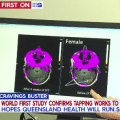If you’re familiar with EFT Tapping, you’ve likely heard of the basic Tapping points like the side of the hand or the eyebrow point. But there’s another powerful point that’s sometimes overlooked: the Gamut point.
This special point, when combined with specific eye movements and humming in what’s called the 9 Gamut procedure, can be particularly powerful for processing difficult emotions and intrusive thoughts.
What is the Gamut point?
The Gamut point is located on the back of either hand, in the indentation between the knuckles of the ring finger and little finger, about half an inch back from the knuckles. This point is also sometimes called the Triple Warmer 3 (TW3) point in traditional Chinese medicine, as it corresponds to the Triple Warmer meridian.
The Gamut point is a unique Tapping point because it’s connected to parts of the brain involved in memory processing and emotional regulation. When we stimulate the Gamut point while performing specific eye movements and actions, we can help our brains process information in new ways.
Tapping or gently massaging this point is thought to help release repetitive thinking, obsessing, and worry, while promoting hope, calmness of mind, clarity, and connection with positive possibilities. It’s a helpful Tapping point to stimulate when feeling stressed or reactive, to help calm the brain and body back down.
The 9 Gamut Procedure: A powerful addition to your Tapping practice
The 9 Gamut procedure is a specialized sequence originally taught by Gary Craig that combines:
- Continuous tapping on the Gamut point
- Nine specific actions performed while Tapping
- Bilateral stimulation through eye movements (similar to techniques used in EMDR).
This combination makes it particularly effective for:
- Processing traumatic memories
- Reducing intrusive thoughts
- Calming anxiety
- Integrating left and right brain activity
- Enhancing overall emotional processing
How to do the 9 Gamut procedure
While continuously tapping on the EFT Gamut point, perform these nine steps in order:
- Close your eyes
- Open your eyes
- Look hard down to the right (keeping your head still)
- Look hard down to the left
- Roll your eyes in a circle clockwise (like you are following an imaginary clock)
- Roll your eyes in a circle counterclockwise
- Hum a few seconds of a tune (like “Happy Birthday,” or “Twinkle Twinkle Little Star”)
- Count from 1 to 5
- Hum a few seconds of a tune again
Gamut point benefits
The Gamut point and 9 Gamut procedure offer several unique benefits:
- Enhanced Bilateral Stimulation: Like EMDR therapy, the eye movements in the 9 Gamut procedure help stimulate both hemispheres of the brain, potentially improving emotional processing.
- Deeper Integration: The combination of Tapping, eye movements, and cognitive tasks helps integrate multiple techniques and thus multiple layers of benefits..
- Pattern Interruption: The sequence helps break negative thought patterns by engaging different parts of your brain.
- Emotional Release: Many find it particularly effective for releasing stuck emotions and processing difficult memories.
- Improved Focus: The procedure may help clear mental fog and enhance concentration.
When to use the Gamut point or the 9 Gamut procedure
The Gamut point and 9 Gamut procedure can be especially helpful when:
- You feel stuck with traditional Tapping, and you aren’t getting the results you’re hoping for
- You are processing trauma (even trauma from when you were so young you can’t distinctly remember it)
- You feel off but don’t know why
- You need to break through emotional blocks
- You want to enhance your regular Tapping routine
You can use the Gamut point in several ways:
- As an addition to the basic Tapping sequence: Include it in your standard Tapping rounds, adding this point to the traditional points.
- As a standalone practice: Simply tap or rub the Gamut point whenever you need quick emotional relief
- Combined with other techniques: It works well with bilateral Tapping, EMDR, and other related techniques



Common Questions About the Gamut Point
Can I skip parts of the 9 Gamut procedure?
While you can, it’s recommended to do all nine steps as each serves a specific purpose in the overall process.
How often should I use the Gamut point in EFT?
You can use it as often as needed, either as part of your regular Tapping routine, as a standalone practice, or whenever you feel stuck.
Does it matter which hand I use?
No, you can use either hand. Choose whichever feels more comfortable.
Ready to experience the benefits of the Gamut point for yourself?
The Gamut point and 9 Gamut procedure offer a unique and powerful addition to your EFT Tapping practice. Whether you’re looking to process difficult emotions, break through mental blocks, or simply enhance your regular Tapping routine, this technique can help take your healing journey to the next level.
Remember, while it might feel a bit unusual at first to do the eye movements and humming, each component of the 9 Gamut procedure serves an important purpose in helping your brain process and release whatever may be troubling you. Be patient with yourself as you learn this technique, and stay open to experiencing its benefits.
And remember you can always just tap or rub on the EFT Gamut point on your hand to experience the benefits right away.
Looking for more guided support for your Tapping journey?
Download The Tapping Solution App today for hundreds of guided Tapping meditations designed to help you find relief from stress, anxiety, difficult emotions, and more.
Until next time… Keep Tapping!
Nick Ortner













Connect With Us on Social Media